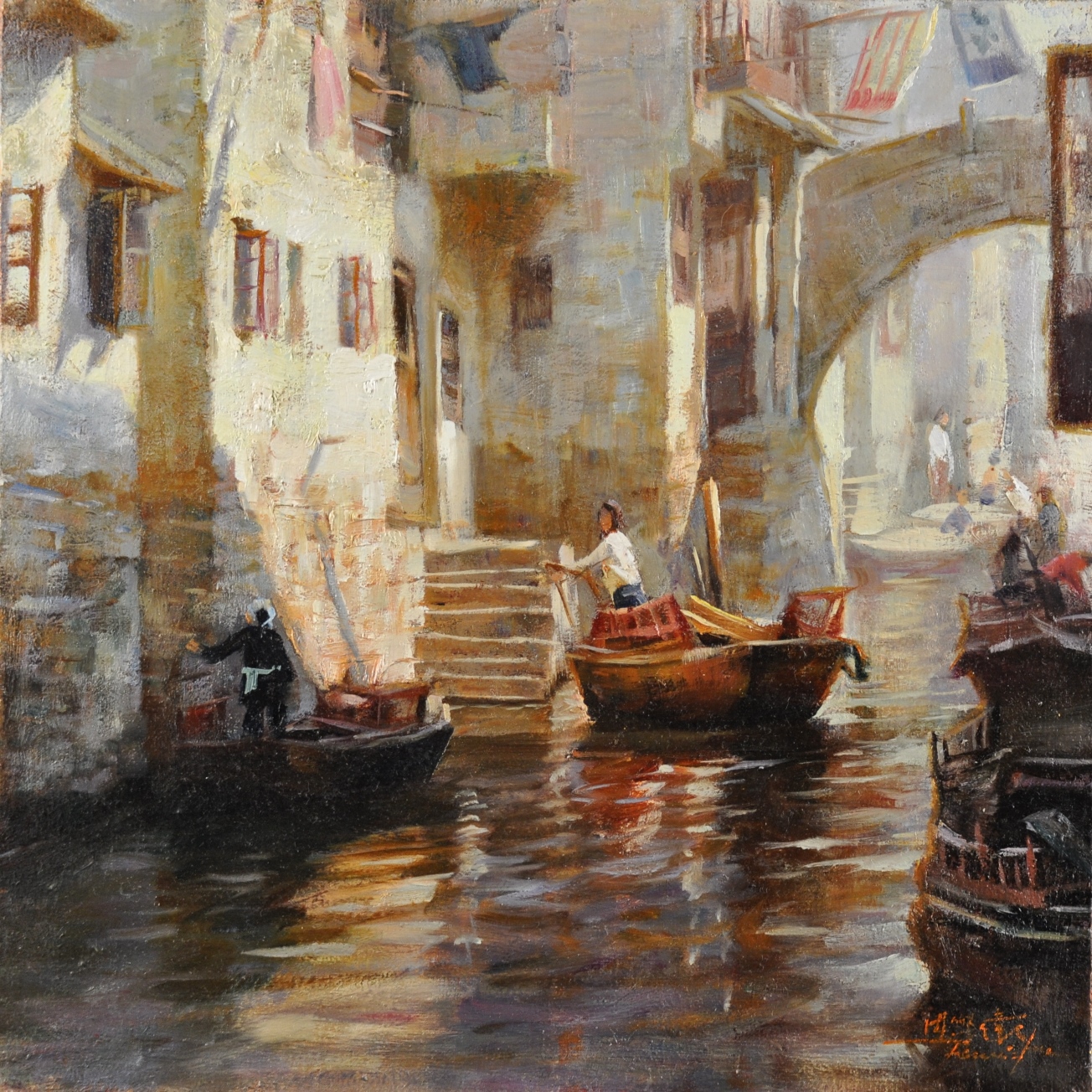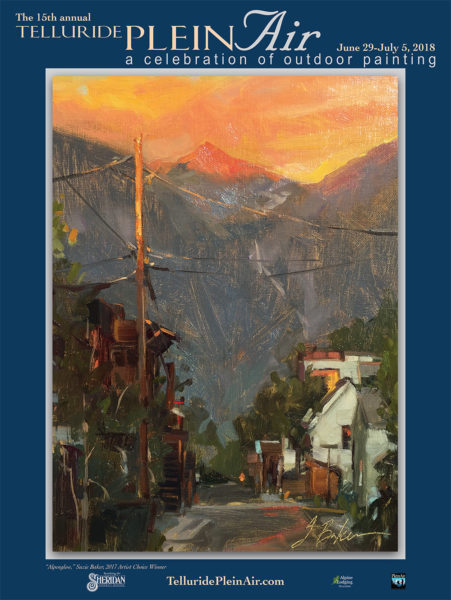
25 Jun Sheridan Arts Foundation: July 4 & 15th Annual Telluride Plein Air
Telluride’s Sheridan Arts Foundation (SAF) welcomes 23 nationally recognized plein air artists to town from June 29-July 5, 2018, all gathered here for the 15th annual Telluride Plein Air. The artists will spend their time painting outdoors as is the tradition, capturing the light, color and unique character of, well, the characters of the region – and the region itself, including the towns of Telluride and Mountain Village.
A three-day Art exhibition and sale is scheduled for July 3, 4 and 5. On display will be completed works of flower-filled meadows, majestic mountains and colorful downtown scenes. Each artist typically paints 10 to 20 pieces during his stay, culminating in collectively more than 250 works to view and purchase over the course of the sale. (Only eight-10 pieces are displayed at one time however.)
New this year: local jeweler Christopher Beaver and local sculptor Richard Arnold will be selling their work on the second two days of the big event, which coincides with Telluride’s no-holds-barred (except for no fireworks this year) celebration of the Fourth of July, a slice of Main Street Americana.
Please scroll down for more on the plein air show, including the debut of one of the special guest artists, Jie Wei Zhou, from Denver.

His work includes an image of a graceful ballet dancer, the signature theme of French Impressionist Edgar Degas.

Ballet Dancer,
Another is of a lovely woman arranging roses in a vase. Both are luminous.

From My Garden
A boat drifts lazily on the water, which reflects the stone building to which the boat is tied up. The canvas is a variation on theme of Monet’s waterlilies in which the water holds and distorts the surrounding landscape, creating an abstraction within the representational scene.

Quiet Afternoon
A book is dive-bombed by apples. Did they just fall from a tree? Did the reader dash away to avoid being clobbered in the head?

Book with Apples
Whatever the case, none of the above resembles traditional Chinese painting, which comes in a variety of styles: monochrome or brightly colored; made in the literati style in which the artist tends to use expressionistic brushwork to express his creativity; made in gong-bi, or “meticulous” style, in which the artist, in contrast to the literati style, depicts very precise details of a scene to create much more decorative work. Chinese painting can be bold and expressive; quiet and detailed.
The most prized Chinese traditional paintings, however, are those that clearly reveal the artist’s personality. (It is believed an evil person cannot make a fine work of art.)
All of the above images represent the work of one particular Chinese artist, Jie Wei Zhou – but none of them meets the criteria for traditional Chinese painting – except one: Zhou’s work reveals the character of the artist as an insightful, sensitive human committed to revealing the nature of his subject rather than the subject itself: appleness rather than apples.
Zhou, who has been living in the U.S. since 1994 and is now a resident, is one of the artists selected through a juried process by a panel of artists, gallery owners and educators to participate in Telluride Plein Air,
Zhou, a master of landscapes, portraits and still life, was schooled in Russian and Western styles of painting, notably Impressionism, a movement started in France with the idea of moving the dial from the prosaic pictorial journalism of the Salon to a kind of mediative natural poetry based on colored light, rather than on a straightforward representation of people, places and things.
Telluride Plein Air 2018 marks Zhou’s debut in town, where he joins gifted colleagues who plant their easels wherever they find inspiration: in alleys; down by the river; smack dab in the middle of Colorado Avenue; and hidden away in various other nooks and crannies of Mother Nature, heads covered from the Colorado sun, brushes flying, canvases exploding with color and light.
Each year, at the SAF’s Telluride Plein Air, other top-selling artists and the Sheridan Arts Foundation’s Artist Choice and top winners from the previous event are invited back to participate. Suzie Baker won Artist Choice in 2017 and was also a top seller, along with Wayne McKenzie, David Dallison, Christine Lashley, Mat Barber Kennedy and Bill Meuser.
The Sheridan Arts Foundation created Telluride Plein Air to support its community programming and the continual upkeep and restoration at the historic Sheridan Opera House in Telluride.
The Sheridan Opera House has provided quality entertainment to Telluride since 1913. All profits from the sale of the artwork are split: 40 percent benefits the Sheridan Arts Foundation’s community programming; 60 percent is retained by the artists.

Farmer’s Market Day, Jie Wei ZHOU.
Diana Conovitz is a former Telluride local who now writes and edits a newsletter for the Asian Arts Association, a Denver Art Museum affiliate. She penned the following piece about her friend Jie Wie Zhou.
Jie Wei Zhou is a master realist painter whose dedication and talent brought him from Shanghai, China to the United States in 1994. His home is both his gallery and his working studio. The realism and technique in Zhou’s paintings are remarkable and reflect his schooling in the Russian and Western style of painting. He doesn’t own a camera, but is not without a sketchbook and relies on memory and observation. For inspiration he goes back to China to revisit places that are familiar and the source of his own personal stories. Zhou is a master of landscapes, portraits, and still life yet he is most drawn to figurative painting.
Zhou’s paintings tell stories. “You can see their story,” he says of his subjects. “I try to show the spirit of people and I want my paintings to stand there like a real person who wants to talk to you.”
Zhou has his own story to tell. It is a story of neighbors, happenstance, and good fortune. He grew up during the Chinese Cultural Revolution and beginning at five years of age he was sent to a neighbor for childcare. The husband of this neighbor was a noted artist and taught young Zhou the principles of drawing. He developed an early passion for art in middle School, where his teachers recognized his gift. He went on to earn a Bachelor of Arts Degree from Shanghai Normal University and in 1991 he became one of only eleven students chosen in his city of thirteen million to earn a Masters in Fine Art from the prestigious Shanghai Drama Institute.
The course of Zhou’s life changed in 1985. While he was plein air painting at a site in China frequented by tourists a couple from Denver, Colorado admired his painting and photographed his work. When they returned home they showed his paintings to their neighbor who was a retired art dealer. Impressed by his work, the dealer offered to represent him in the United States. Zhou achieved his dream of living and painting in America by sending his rolled canvases to the US. and each time a gallery sold his artwork his money was deposited into a U.S. bank account to pay for his future passage. Zhou is now a U.S. resident and through his painting he continues to remember and honor his cultural roots. His subjects include Chinese children with ducks, tribal and ethnic cultures, and Native Americans. Zhou is a collector of ethnic textiles and jewelry and he will adorn his subjects in pieces from his collection. His beautiful wife, Yan, is often his model.
Curator Dr. Tianlong Jao met Jie Wei Zhou at a show of his work at the Denver Athletic Club and it is from this meeting that members of the Asian Art Association had the pleasure of a salon at his home studio. Zhou’s work is may be seen in galleries in Scottsdale, Arizona, Jackson Hole, Wyoming, Santa Fe, New Mexico, and at the Broadmoor Gallery in Colorado Springs.
More about Impressionist or plain air painting:
What’s it all about? Well, “plein air” is a concept first associated with the French Impressionists and in that context is shorthand for “very spendy, but would look great in your living room if you could afford one.”
Just kidding.
The story actually begins with Eugene Boudin, one of the more adventurous 19th-century painters, known primary for his beach scenes and seascapes of northern France, and luminous skies. When Boudin taught his young student, Claude Monet, the importance of painting a scene directly from nature in the light, in the air, just as it was, painting en plein air was born.
In the stroke of Monet’s agitated brush, the dark palette of Realism (and the Barbizon School) gave way to the brighter highlights of painting directly from nature.
Monet quickly introduced friends such as Renoir, Sisley and Bazille to the core idea of the discipline: record only what is visible at given distances under specific lighting conditions. In December 1873, outdoor painting sessions and heated café discussions among young artists of the day culminated in the Societe Anonyme des Artistes
The group’s first show, April 15, 1874, included an image by Monet of dawn over a foggy harbor entitled “Impression: Sunrise.” A critic wrote a satirical review, sniffing at the Monet, and in one stroke of a venomous pen, he popularized the term “Impressionism,” now synonymous with plein air painting.
The first important Impressionist work to be shown in America was Manet’s “Execution of the Emperor Maximilian,” banned by Paris censors and politically inflammatory. According to art critic Robert Hughes, in 1879 the image was brought to New York and Boston by an opportunistic singer named Madame Ambre who put on a show to generate publicity for her recitals.
In 1886, a popular French art dealer mounted the first professional show of Impressionist images at the American Art Association’s galleries. Thus began America’s love affair with fine European works of art. In a heartbeat, American artists began to adopt plein air techniques.
Much late 19th- and early 20th-century painting stems from reactions to Impressionism’s basic tenets.
And the beat goes on…


Pingback:Sheridan Opera House, 7/1 - 7 | Telluride Inside... and Out
Posted at 18:34h, 26 June[…] Sheridan Arts Foundation: July 4 & 15th Annual Telluride Plein Air – June 25, 2018 […]